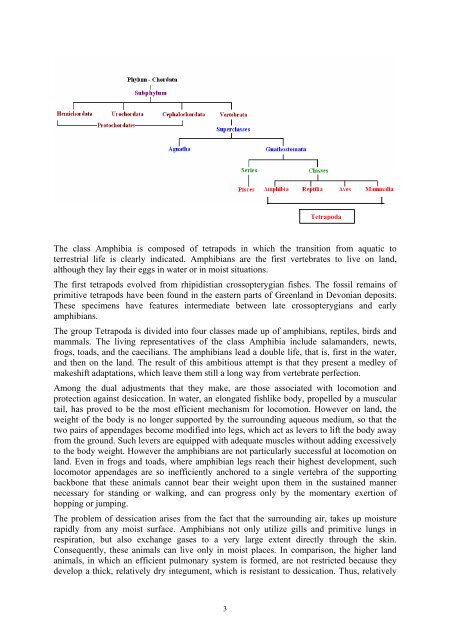Animal Diversity: Chordata
Animal Diversity: Chordata
Animal Diversity: Chordata
You also want an ePaper? Increase the reach of your titles
YUMPU automatically turns print PDFs into web optimized ePapers that Google loves.
Tetrapoda<br />
The class Amphibia is composed of tetrapods in which the transition from aquatic to<br />
terrestrial life is clearly indicated. Amphibians are the first vertebrates to live on land,<br />
although they lay their eggs in water or in moist situations.<br />
The first tetrapods evolved from rhipidistian crossopterygian fishes. The fossil remains of<br />
primitive tetrapods have been found in the eastern parts of Greenland in Devonian deposits.<br />
These specimens have features intermediate between late crossopterygians and early<br />
amphibians.<br />
The group Tetrapoda is divided into four classes made up of amphibians, reptiles, birds and<br />
mammals. The living representatives of the class Amphibia include salamanders, newts,<br />
frogs, toads, and the caecilians. The amphibians lead a double life, that is, first in the water,<br />
and then on the land. The result of this ambitious attempt is that they present a medley of<br />
makeshift adaptations, which leave them still a long way from vertebrate perfection.<br />
Among the dual adjustments that they make, are those associated with locomotion and<br />
protection against desiccation. In water, an elongated fishlike body, propelled by a muscular<br />
tail, has proved to be the most efficient mechanism for locomotion. However on land, the<br />
weight of the body is no longer supported by the surrounding aqueous medium, so that the<br />
two pairs of appendages become modified into legs, which act as levers to lift the body away<br />
from the ground. Such levers are equipped with adequate muscles without adding excessively<br />
to the body weight. However the amphibians are not particularly successful at locomotion on<br />
land. Even in frogs and toads, where amphibian legs reach their highest development, such<br />
locomotor appendages are so inefficiently anchored to a single vertebra of the supporting<br />
backbone that these animals cannot bear their weight upon them in the sustained manner<br />
necessary for standing or walking, and can progress only by the momentary exertion of<br />
hopping or jumping.<br />
The problem of dessication arises from the fact that the surrounding air, takes up moisture<br />
rapidly from any moist surface. Amphibians not only utilize gills and primitive lungs in<br />
respiration, but also exchange gases to a very large extent directly through the skin.<br />
Consequently, these animals can live only in moist places. In comparison, the higher land<br />
animals, in which an efficient pulmonary system is formed, are not restricted because they<br />
develop a thick, relatively dry integument, which is resistant to dessication. Thus, relatively<br />
3

















